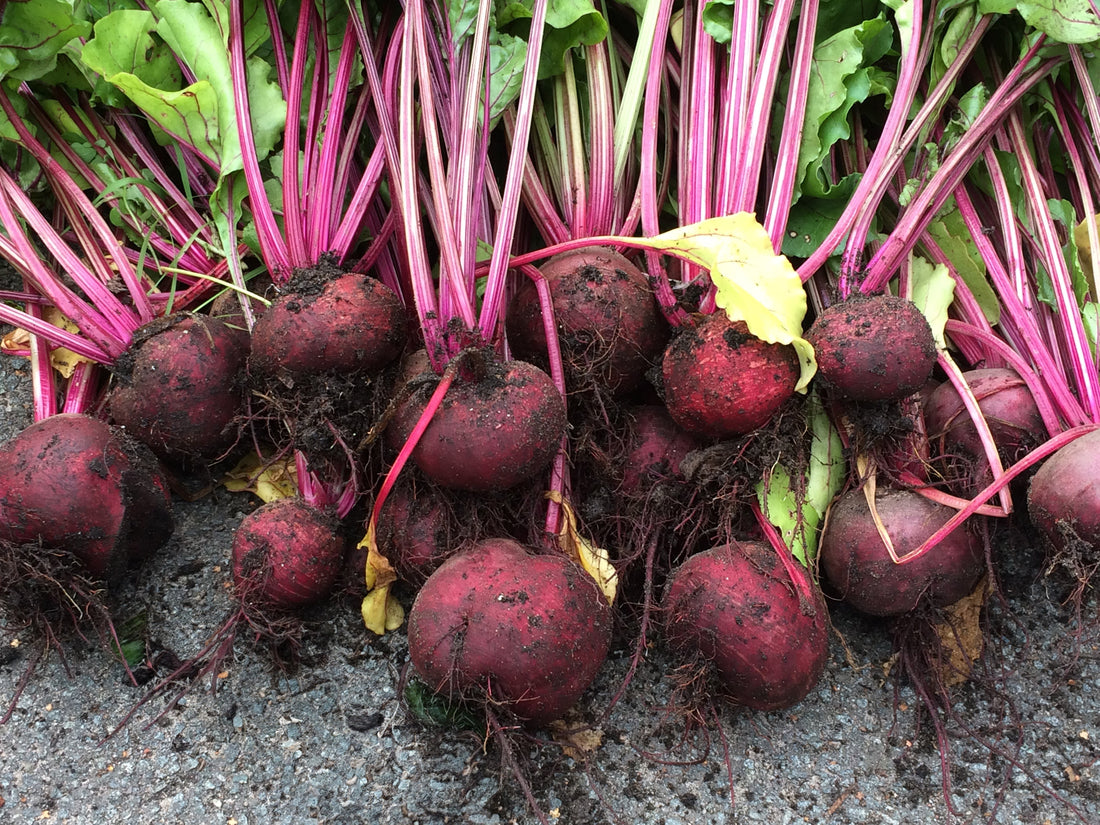
How to Grow Beetroot from Seed
Beetroot is a resilient, easy-to-grow vegetable well-suited to the UK’s climate. Known for its earthy flavour, vibrant colour, and high nutritional value, beetroot can be grown in most gardens and even in containers. This guide will walk you through the process, providing practical advice for each stage.
Introduction to Growing Beetroot from Seed
Beetroot (Beta vulgaris) has been cultivated for centuries for both its roots and greens. It’s naturally rich in vitamins, minerals, and antioxidants, making it a healthy addition to meals. Beetroot thrives in the UK's mild climate and can be grown from early spring to autumn, allowing for multiple sowings and harvests throughout the season. Whether eaten fresh, pickled, or stored for winter use, beetroot is a rewarding crop for both beginner and experienced gardeners.
Choosing the Right Beetroot Variety for the UK
The UK’s climate is suitable for many beetroot varieties, each with unique flavours and colours. Here are some popular choices:
- Boltardy: A classic beetroot variety ideal for UK gardens, known for its bolt resistance, making it suitable for early sowing.
- Detroit: A deep red, smooth-skinned beetroot with a sweet, earthy flavour. It matures quickly and stores well.
- Chioggia: This Italian variety has striking pink and white rings. It’s known for its mild flavour and visual appeal in salads.
- Golden: With a milder, slightly sweeter taste, golden beetroot doesn’t stain as much as red varieties, making it great for cooking.
Each of these varieties offers unique benefits. Bolt-resistant varieties like Boltardy are ideal for early sowings in the UK, while others like Chioggia add visual interest and unique flavours.
Preparing the Soil for Beetroot
Beetroot grows best in well-draining, fertile soil. Proper soil preparation is crucial for smooth, even roots.
- Loosen the Soil: Beetroot needs soil that’s loose and stone-free to allow for root development. Use a fork to dig the soil to a depth of about 20-30 cm. In areas with heavy clay, add sand and organic matter to improve texture and drainage.
- Soil pH: Beetroot prefers a neutral to slightly alkaline pH (6.5-7.5). In acidic soils, add garden lime a few weeks before planting to raise the pH if needed.
- Adding Organic Matter: Work in well-rotted compost or manure during autumn, allowing it to break down before spring planting. This provides nutrients and helps retain moisture. Avoid fresh manure, as it can encourage leaf growth rather than root formation.
Beetroot grows well in raised beds or containers, especially if your garden soil is prone to poor drainage or compaction.
Planting Beetroot Seeds
Beetroot can be sown directly into the soil and doesn’t require indoor germination.
- When to Plant: In the UK, beetroot can be sown from early spring (March) until late summer (August), allowing for multiple sowings throughout the growing season.
- Sowing Technique: Sow beetroot seeds about 1-2 cm deep and space them 10 cm apart. Rows should be spaced around 30 cm apart to give roots enough room to grow.
- Succession Sowing: For a steady supply of fresh beetroot, sow seeds every 3-4 weeks from March until mid-August. This will ensure a continuous harvest and prevent a glut.
- Watering After Sowing: Water the soil well after sowing, keeping it moist until the seeds germinate, which typically takes 7-14 days.
Beetroot seeds are actually seed clusters containing multiple seeds, so it’s common to see several seedlings emerge from each “seed.” These clusters will need thinning later on to ensure each plant has space to develop fully.
Watering and Fertilizing
Beetroot is relatively low-maintenance but requires consistent moisture and nutrients.
- Watering: Beetroot prefers consistent moisture, especially during the early stages of growth. Aim to water deeply once or twice a week, increasing frequency in hot, dry weather. In the UK’s wet climate, rain may cover most of the water needs, but be sure to water during dry spells.
- Fertilizing: Beetroot is a light feeder, so excessive fertilisation isn’t necessary. A balanced fertiliser or compost worked into the soil before planting provides the nutrients needed for healthy root development. If additional feeding is necessary, avoid high-nitrogen fertilisers, as they promote leaf growth rather than root development.
A good balance of nutrients, particularly potassium and phosphorus, encourages robust root growth and enhances flavour.
Thinning and Managing Growth
Thinning and regular maintenance are essential for optimal beetroot growth.
- Thinning Seedlings: Beetroot seeds grow in clusters, so you’ll often need to thin seedlings once they reach about 2-3 cm in height. Thin to leave the strongest seedling per cluster, spacing plants about 10 cm apart.
- Weeding Carefully: Beetroot roots grow close to the soil surface, so take care when weeding. Hand-pulling or using a small hoe can help avoid root disturbance.
- Mulching: Applying a thin layer of mulch around plants can help retain moisture, suppress weeds, and regulate soil temperature. Straw, compost, or grass clippings work well as mulch for beetroot.
Avoid overcrowding, as competition can lead to stunted growth. By spacing plants well and maintaining the soil, you can improve both root size and flavour.
Pest and Disease Management
Beetroot is relatively resistant to pests and diseases, but a few common issues can still arise:
- Flea Beetles: Small holes in beetroot leaves often indicate flea beetles. Using a floating row cover or fleece can help protect young plants, especially in spring.
- Aphids: These small insects can cluster on leaves, sucking sap and weakening plants. Introduce natural predators like ladybirds, or spray aphids with a mild soapy water solution.
- Downy Mildew: This fungal disease is common in damp conditions. It appears as yellow spots on leaves. Avoid overhead watering and maintain good airflow by spacing plants properly.
Beetroot is relatively hardy, but crop rotation can help prevent disease buildup in the soil and reduce pest issues year after year.
Harvesting and Storing Beetroot
Knowing when and how to harvest will help ensure your beetroot is flavourful and tender.
- When to Harvest: Most beetroot varieties are ready for harvest within 8-10 weeks. Beetroot can be harvested at various sizes, but smaller roots (around the size of a golf ball) are often the most tender and sweet.
- Harvesting Technique: Gently loosen the soil around the beetroot with a garden fork, then pull the root by hand. Handle carefully to avoid bruising, as this can reduce storage life.
- Storing Fresh Beetroot: Trim the leaves to about 2-3 cm above the root to reduce moisture loss, but avoid cutting too close to the root to prevent “bleeding.” Store fresh beetroot in a cool, dark place, or refrigerate in perforated plastic bags.
- Overwintering: In mild regions of the UK, late-sown beetroot can be left in the ground over winter. Cover with a thick layer of mulch to protect from frost and harvest as needed.
For long-term storage, beetroot can also be pickled or canned, preserving its flavour and nutritional benefits.
Common Problems and Solutions
Even with good care, beetroot can sometimes face issues. Here are common problems and how to address them:
- Forking or Misshapen Roots: Often caused by rocky or compacted soil, or from excessive nitrogen in the soil. Make sure to remove stones and avoid high-nitrogen fertilisers.
- Poor Germination: Beetroot seeds can sometimes have low germination rates, particularly in cold or waterlogged soil. Sow in well-drained soil in spring, and consider pre-soaking seeds for a few hours to improve germination.
- Yellowing Leaves: This can indicate a nutrient deficiency, typically nitrogen or potassium. Adding a balanced fertiliser or compost can help restore green, healthy growth.
Rotating crops each year can help prevent disease buildup, and adding organic matter each season keeps soil in top condition.
Frequently Asked Questions
Q: Can I grow beetroot in containers?
A: Yes, beetroot grows well in containers. Use a pot at least 25 cm deep with good-quality, well-draining compost. Thin seedlings to provide enough space for root growth.
Q: How do I make my beetroot taste sweeter?
A: Beetroot grown in cooler temperatures (like early spring or autumn) tends to have a sweeter, milder flavour. Consistent watering and avoiding high nitrogen also improve flavour.
Q: Should I harvest beetroot greens?
A: Yes, beetroot greens are edible and can be harvested without harming the root. Cut a few leaves from each plant, rather than all at once, to maintain plant health.
Summary and Additional Resources
Beetroot is a rewarding and versatile crop, and with the UK’s mild climate, you can enjoy fresh, tender roots from spring through autumn. Here’s a recap:
- Prepare loose, stone-free soil with added organic matter for strong root growth.
- Sow seeds directly from early spring to late summer, spacing well and thinning seedlings.
- Water consistently, manage weeds carefully, and protect young plants from pests.
- Harvest when roots reach the desired size, trim tops, and store in a cool place.
For further guidance, consider resources from the Royal Horticultural Society (RHS) or books like "Grow Your Own Vegetables" by Joy Larkcom, a staple for UK gardeners.
Following these steps, you’ll have a bountiful crop of delicious beetroot ready for the table or to be preserved for later enjoyment!
